War and Post War Years
Pat Barnes
Pat Barnes bought Don Martinez' fly shop in 1943--which was almost Post War--and ran it exceptionally well until 1981 when both he and his wife Sigrid (Sig) retired to their home in Helena Montana. Pat spent the rest of his life tying flies and rowing and fishing the Missouri. Pat loved fishing, fly tying and boats. He was the first one to bring McKenzie River Boats to Montana in 1948.
I know so many Pat Barnes stories I can't tell them all. Successful fly shop owners tend to be extroverts who have a zillion friends. My dad was one of them. Later in his life when Pat was retired and seldom ventured far from his Helena Montana home, I fished with him a few times up on the Missouri. Both times I brought one of my own boats up from Bozeman, which Pat said he liked but he still preferred his old Keith Steele boat because mine were too complicated. "Everything's adjustable," he complained.
He loved to tell stories about how crazy my dad was. His favorite story was about the time my dad had a temper tantrum at an all you can eat beef stew buffet in West Yellowstone where late in the day they were serving beef-less stew. My dad walked up to the counter with a loud voice and complained he'd been all day fishing on the Madison and now he was fishing once again. And he didn't like getting skunked on beef. Pat always finished that story by slapping his thigh.
One of the times I fished the Missouri I stayed with Pat and Sig at their house in Helena so we could get an extra early start. We drifted a lower canyon section that included a few braided channels down near the takeout. Pat had a new gray and red marabou streamer fly he called the Scud. Pat called it a Scud because it looked like a cloud he said.
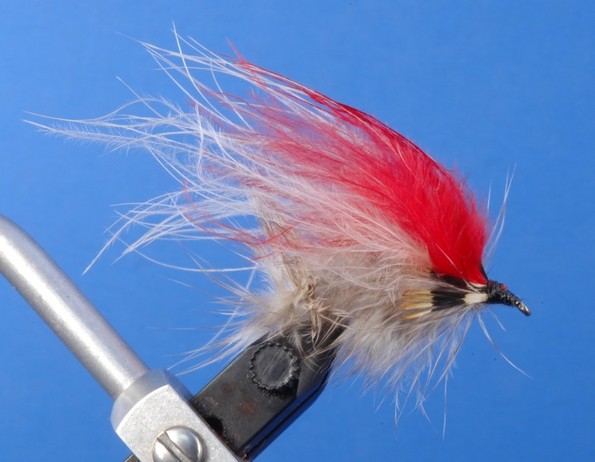
Pat insisted on taking the oars from the getgo. He insisted I fish with his new creation the Scud too. I caught a small brown trout up against a rock wall across from the put in almost right away and then struggled for a while. At one point, when Pat wasn't looking, I put on a streamer of my own, one I called the Knucklehead Sculpin. Two or three casts later I hooked a beautiful well-developed male brown trout about 17" long. Pat was beaming from ear to ear as he reached out across the gunwale to net the fish that had--he thought--taken his new Scud. But when he saw the fish had a strange olive-green tinselly creation in its mouth he frowned disgustedly and said "The fishing must really be good today!"
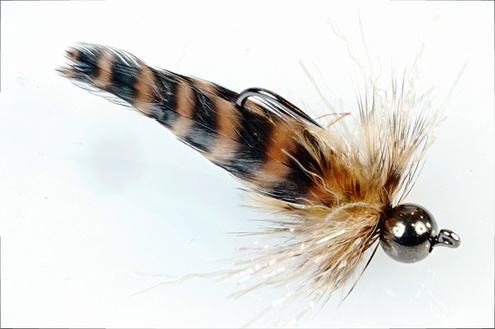
Pat grew up in Three Forks at the beginning of the last century. Before FDR's CCC Core channelized the Madison below what is now the Gray Cliff fishing Access the Lower Madison was all channels. Pat told me ten pound fish were common. He also told me about a spring creek down near the Headwaters where he once caught a 14lb brown while on a quick trip driving back to Helena from West Yellowstone. I know that place but I won't say exactly where it is. It's all posted and private now anyway. The Lower Gallatin has lots of slow moving spring creeks that seep in way down low. Most of them look like froggy lagoons where they actually enter the river. If you know were to park a boat you can slowly wade upstream legally because of Montana's Stream Access Law. But the lower one or two hundred yards of all those creeks can be waste deep in beaver mud. It's not an easy slog. Later that day Pat showed me an ancient Raccoon crayfish cleaning and eating spot underneath a noisy interstate highway Bridge where overflow from a small spring creek/irrigation ditch flows in. Dead crawfish bodies made a shell pile a good 4" inches high and ten feet wide. Pat said that pile of crayfish shells had been there ever since he could remember. Pat tied on a crayfish pattern and caught the following 18" inch darkly colored brown trout as I watched. Those crayfish shells all got washed away about ten years back in a high water year. The pile is already starting to regenerate.
Pat's Flies
The flies Pat is best remembered for where the Goofus Bug (which later became the Humpy) the Sofa Pillow and the Jughead. He also tied a PW Nymph (Pat's weighted nymph) that was similar to the older Don Martinez Black Nymph, tied with a peacock herl body instead of black yarn. Pat never claimed to have invented the Goofus Bug. That was a Jack Horner invention. But Pat renamed it and made it one the West's most popular dry flies. Was it Jack Dennis who renamed it once again so the Goofus Bug became the Humpy? Among friends and guides who worked for him Pat like to laugh and refer to the Humpy as "A poorly tied Goofus Bug."
All the flies shown here were actually tied by Pat. Sig Barnes tied most of the flies they sold in the shop, so when Pat gave me a box of flies at the dinner table I asked how I'd ever know which of the two actually tied them. Sig smiled and said "I haven't tied a single fly since we sold the shop, except for fund raisers anyway." Pat's flies were noticeably messier than Sig's, which also gave me confidence the following were all his ties.
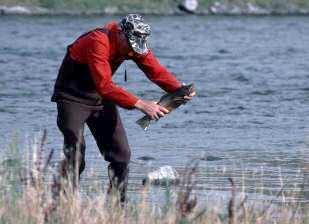
When I worked at the Yellowstone Angler in the early 1990s we were told we were under no circumstances allowed to fish. Not unless the customer expressly asked us to. Pat was at the other end of the distribution. Pat often said the most essential pieces of fishing equipment were a rod, a reel, a box of flies and a customer. When out on the river Pat did row the boat. But the minute the anchor went down he was out of the boat, fishing like a fiend. Pat was the only guy who could get away with it. Pat did what ever he wanted when ever he wanted. Everybody loved him for it too. Pat rowed his old Keith Steele boat "The Old Pro" right up until the end. He died at 86 years old.
The most interesting thing I learned from Pat during those late years on the Missouri was the way he fished dry flies. Pat didn't fish Sparkle Duns or parachutes or no-hackle dry flies on the Missouri the way so many people do now. He still fished Goofus Bugs and Wulff flies but he did make them smaller and sparser than his Madison River versions, like the following Ginger Goofus.
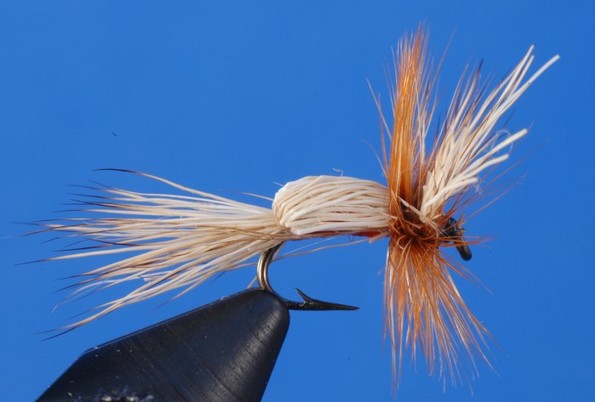
More to the point Pat intentionally cast his dry fly line with as many loops and squiggles as possible, from the end of his rod all the way out to the fly. When a fish did strike he didn't lift his rod tip. He strip struck the line with his left hand like a Bahamas bonefish guide. And he also sharply twitched his rod tip. But he didn't lift the rod tip. "Lifting does nothing," he said. Instead he twitched the rod sideways, parallel to the water. The combination of those two left and right hand actions made the line instantly move like a snake, all the way out to the fly. "You get a much longer drag free float this way," he told me.
Pat accomplished his squiggle cast by intentionally shaking the rod tip as he cast and by grabbing the line with his left hand a moment before it stopped shooting through the guides, so the cast actually bounced back a bit as it slowly setting down on the water. Pat's casts didn't splash the water. They came to a graceful loopy termination a foot or so above the water and then dropped down quietly, loops and all. He was an old pro.
Not many of Pat's patterns are still in use today. His Sofa Pillow--once a West Yellowstone mainstay--gradually got replaced by the Bird's Stonefly. And then again by today's unsinkable foam patterns. He was a great guy. One of the best ever.
Woolly Bugger
Most sources credit Pennsylvania tier Russel Blessing as the creator of the Woolly Bugger--perhaps as early as 1967. Football and baseball and basketball fans are addicted to continually editing and re-editing their top ten players of all time lists. Is there a greatest top ten flies list? Of all time? I don't have a list like that but if I did I'm sure I'd have the Woolly Bugger in there somewhere. And I probably would not have its clear progenitor there--the Woolly Worm--even though it is still a very good fly. Swapping out the red tag butt for a wafting long marabou tail was one of the best sports trades ever made.Most people I know make black or olive bodied Woolly Buggers with a brown black or grizzly saddle hackle wound over top. Olive Woolly Buggers look like drifting water weeds to me. So I tend to make my Buggers black and/or brown rather than olive. But that's an instinctive prejudice at work that doesn't really make sense. I admit it. So many good fish have been caught on Olive Woolly Buggers it's hard to argue against. I've had to expunge so many prejudices over the years I find myself clinging jealously to the few that still remain.
My old and now departed fly tying and fishing buddy Willy Self tied a dark Olive Woolly Bugger with a thick strand of clear "Lateral Scale" down each side of the body. Willy called that fly his Lunch Special. I've only regularly fished with a few people in my life who consistently out-fished me. Willy was one of them. I've watched him catch so many fish on the Lunch Special it's hard to know how to adequately say it in words. Willy died after a car crash a few months ago. He taught me a lot about fly tying. I make black or brown bodied Lunch Specials now. I'll have to loosen up a bit and make a dark olive Buggers too. With the Lunch Special streak on each side.
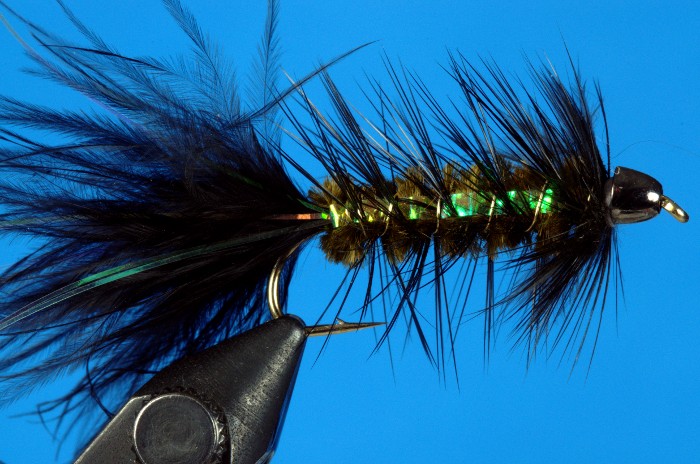
Polly Rosborough
"In 1965 Polly self-published his first book "Tying and Fishing the Fuzzy Nymphs." That's a quote from the great spencerewert.com website. So Polly, who was born in 1902 (the same year as Norman MacLean), didn't actually publish until was over 60. He was a prolific tier in the Post War Years. The Zug Bug might have come to us a few years even earlier, but Polly was in many ways the father of USA nymph fishing.
Skip Hosfield, who knew and fished with Polly, had one of the best still surviving Polly Rosborough collections. Skip donated his collection to the AFF Museum a few years ago. I got to photograph that collection a year or two before Skip donated it. Skip's comments about Polly and his flies are interesting.
jAt that time (1958) I had been tying flies off and on for about twelve years, but in the Eastern or Catskill style. Polly's flies were an astonishing revelation to me. His flies were big, fuzzy, impressionistic and tied on very stout Allcocks sproat hooks. When he told me the size of the trout coming out of the Williamson River I understood why.
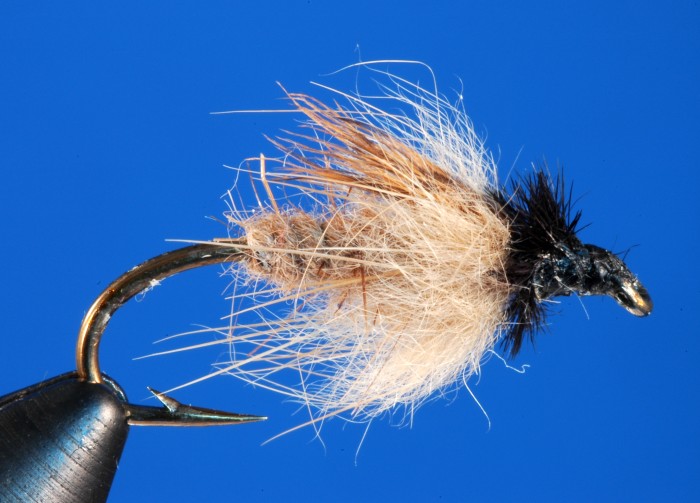
Bud Lilly
Bud Lilly was not a fly designer. He sure did have a big impact. Like Dan Bailey Bud was an extra smart guy with a science background. I Bud also had a photographic memory, which helps a lot in a business like fly shopping. Bud was an easy going guy. He made you feel like talking to you was the most interesting thing he could possibly be doing right now. And he remembered everything you said. Forever.
When I was a teenager we had a cabin over on the Clark's Fork of the Yellowstone, on the East side of the Park. My dad was an academic so we got to spend two or three months there every year. Academic life doesn't work that way now but it did back then. We probably got over to West Yellowstone 3 or 4 times every Summer. Colin, my dad, was primarily a Pat Barnes customer but we did go over the Bud Lilly shop a few times. I must have been 15 or 16 years old. Maybe 17.
Ten years later when I was 27 or so and had just moved up to Bozeman from Southern Colorado I went down to West. Pat's shop was open but Pat was out guiding somewhere. I wandered around town. We ate lunch at a fabulous Romanian deli that no longer exists. I wandered into Bud Lilly's fly shop. Bud looked at me and narrowed his eyes. He shook his forefinger at me and said "I know you. You're, you're Colin Pittendrigh's son! Is it Sandy?" Holy cow. I'd been in that store once in my life ten years earlier. Bud remembered everything. Fun guy too. Later in life I ran into Bud quite a few times at FFF conclaves where I went to show boats. When I had a boat shop out in Gallatin Gateway Bud either called or stopped by a few times. He hired me to make repairs on a few of the older wooden boats they still had. Just seeing that guy made you smile. Bud was a special guy.
Tom Morgan Ed Curnow Carp Story
The fishing from Tosten dam down stream for the next ten miles or so used to be spectacular back in the 1960s, and to a slightly lesser extent into the 1970s. It can still be good fishing today but nothing like it was. Canyon Ferry dam was completed in 1954, thereby radically transforming the few miles of Missouri River downstream to Houser Dam. Canyon Ferry had a big effect on the river upstream too. The Missouri upstream from Canyon Ferry has a tendency to turn chocolate brown with silt a lot, but it wasn't quite so bad in the late 1960s and early 1970s. After the reservoir was completed schools of large lake fish liked to run upstream at different times of year, looking for places to spawn. There was and still is a Spring run of Arlee Rainbows and an odd Fall run of DeSmet rainbows that for what ever reason do spawn late. In October/November huge brown trout from the reservoir would migrate upriver to the small dam at Tosten, where they would stack like cord wood in frothy water below that dam.I did a double trip there with Ron Scott once in the early 1980s, from Tosten down to Deepdale, which has now been renamed as York's Island. We didn't catch a lot of fish but we did well enough to make it a successful day. We caught a bunch of fish in a plume of muddy water coming in at Turkey Creek, and then it slowed down. I hugged the bank and fished hard were ever there was some current, where ever it looked more like a trout stream than a slowly moving lake.
Right across from the takeout at Deepdale one of my guys hooked and landed a 22" inch rainbow. I thought I was hot stuff. A few hours later, after our guys had left Ron and I had a beer at the White Beaver Bar in Tosten, which used to feature a three hundred pound very clean pig that liked to drink beer from a galvanized tub in the middle of the bar's seating area. They sold a lot of beer with that pig. At the bar I retold the story of the 22" rainbow to Ron. The bar tender wandered over my way, put his elbows on the bar and said "Son. We had a 15 pound brown in here yesterday."
One other good story I remember about fishing the Missouri above Canyon Ferry 40 or more years ago came from Tom Morgan. Tom fished there a lot back in the late 1960s, at least in the Fall. Tom told me he was drifting down below Tosten one day with two guys and a tin boat when they ran into Ed Curnow, who announced he just caught two rainbows over ten pounds in the middle of a big school of carp. "They go there to eat the carp shit," Tom said Ed said.
I asked Tom if he believed that story. Tom refused to speak. He just grinned. I'd seen Tom make that mischievous ear to ear grin before. I knew what it meant.
There are big walleyes in that bit of river now. You don't catch them by banging the banks. You have to dredge the middle of the river, deep and slow with big streamers. Some guys I know from Helena caught a 14 pound walleye there a few years back. On trout gear. They grilled it and ate it. A few days later they were told it would have been an 8lb test record for fly gear.
When I told Willy Self those stories he pointed out I was doing everything wrong from the getgo. "Those are reservoir fish," Willy said. "They don't like the current. You have to fish the slack water eddies below the bends in the rivers. That's where lake fish like to hang out."